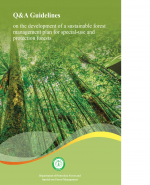Q&A Guidelines on the development of a sustainable forest management plan for special-use and protection forests

Sustainable forest management (SFM) is an important solution for the management of forest resources, improving their economic, social, and ecological value. Implementation of sustainable forest management plans (SFMP) contributes to protecting and developing forest resources and improving the environment, ecology, economic efficiency, and the lives and cultures of local people. Although substantial efforts have been made by the government and stakeholders, the results of SFM implementation in Vietnam have been limited. In response, the 2017 Forestry Law stipulates that forest owners develop and implement a SFMP and assigns the Ministry of Agriculture and Rural Development to guide implementation. MARD issued Circular No. 28/2018/TT-BNNPTNT on sustainable forest management. SFMPs are important tools that help forest owners define and achieve forest management objectives in accordance with the requirements of SFM.
In 2018, the Vietnam Administration of Forestry issued a handbook and guiding documents for the implementation of sustainable forest management. However, when developing and approving SFMPs, forest owners, as well as appraisal and approval agencies, still face several issues that require clarification from authorities or experts, especially on SFMPs for special-use and protection forests. These forest categories are managed by complicated management regulations, with priority given to the implementation of environmental, ecological, and social objectives. The liability of forest owners is high, requiring sufficient information and the legal basis to identify activities, estimated budget needs, and clear funding sources. The approval process is also scrutinized and involves several appraisal authorities. This handbook has been developed with the aim of providing information and clarifying common problems encountered during the development of SFMPs for special-use and protection forests. Its contents are structured in a question and answer format based on the common problems encountered by forest owners and authorities that are not mentioned in specific regulations or guidelines.